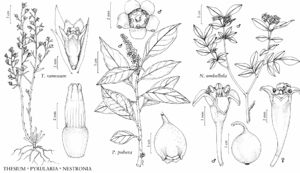Difference between revisions of "Cervantesiaceae"
FNA>Volume Importer |
imported>Volume Importer |
||
| (One intermediate revision by the same user not shown) | |||
| Line 42: | Line 42: | ||
|publication year= | |publication year= | ||
|special status= | |special status= | ||
| − | |source xml=https:// | + | |source xml=https://bitbucket.org/aafc-mbb/fna-data-curation/src/2e0870ddd59836b60bcf96646a41e87ea5a5943a/coarse_grained_fna_xml/V12/V12_359.xml |
}}<!-- | }}<!-- | ||
-->[[Category:Treatment]] | -->[[Category:Treatment]] | ||
Latest revision as of 19:15, 5 November 2020
Shrubs [trees], root parasites, deciduous, dioecious [synoecious, polygamous, trioecious]. Leaves alternate, simple; stipules absent; petiole present; blade margins entire [spinose]; venation pinnate. Inflorescences unisexual, terminal or axillary, racemes [spikes, cymes, panicles]. Flowers unisexual [bisexual]; perianth and androecium perigynous or epigynous; hypanthium completely adnate to ovary; sepals 0; petals (4–)5(–6), distinct, post-staminal hairs present; nectary present; stamens (4–)5(–6), opposite petals, distinct, adnate to petal base; anthers dehiscing by longitudinal slits; staminodes present in pistillate flowers; pistil 1, carpel number unknown; ovary 1/2 inferior (staminate flowers) or almost superior (pistillate flowers), becoming inferior during fruit development, 1-locular, placentation free-central, pendulous; ovules 2–3 per locule, anatropous; style 1; stigma 1; pistillode present in staminate flowers. Fruits pseudodrupes (mesocarp hard). Seeds 1 per fruit.
Distribution
e, se United States, South America, Asia, Africa.
Discussion
Genera 8, species 20 (1 in the flora).
Cervantesiaceae show a trend from bisexual to fully unisexual flowers, with intermediate stages seen by the presence of staminodes and pistillodes, as well as trioecy in Scleropyrum Arnott. Carpel number in Cervantesiaceae is unclear and the necessary anatomical studies have not been done. The fruits in this family (the largest in Santalales) have a hard or crustaceous mesocarp. Because the mesocarp is hard, not the endocarp, these are considered pseudodrupes, not true drupes. In Jodina Hooker & Arnott ex Meisner, the endocarp is apparently consumed during endosperm development (S. P. Bhatnagar and G. Sabharwal 1969); this interpretation is extended to other members of the family.
The affinity of the eight genera of Cervantesiaceae, first noted by H. U. Stauffer (1957, 1961), was confirmed using molecular phylogenetic methods (J. P. Der and D. L. Nickrent 2008; Z. S. Rogers et al. 2008). The segregation of Cervantesiaceae from Santalaceae in the broad sense follows the classification of Nickrent et al. (2010). Pyrularia is the only genus in the family with species occurring in both the Old and New Worlds.
Selected References
None.
